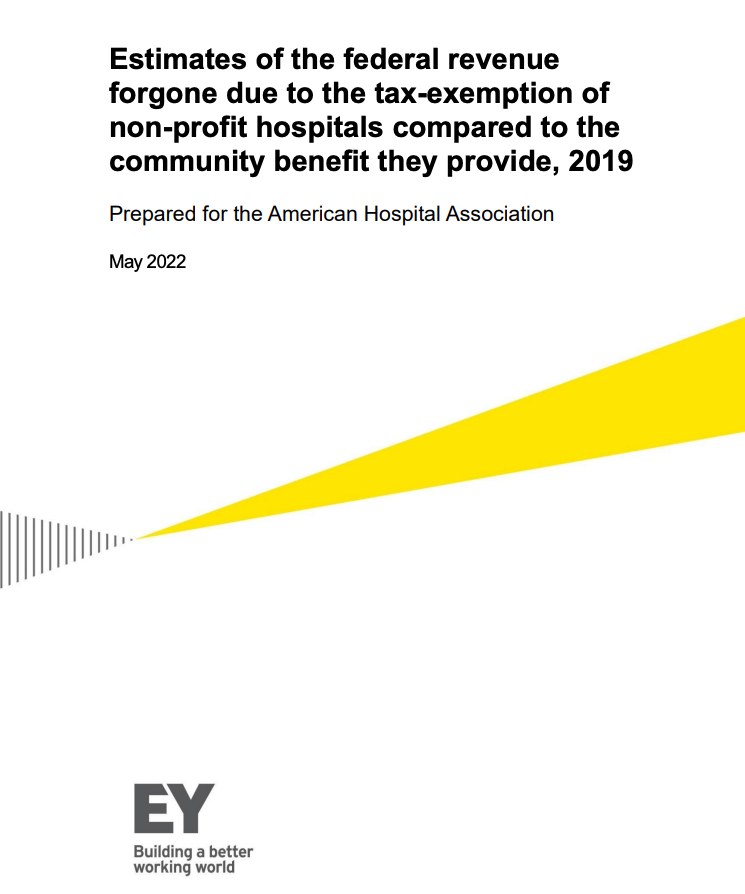

Estimates of the Federal Revenue Forgone Due to the Tax-Exemption of Non-profit Hospitals 2019
Estimates of the Federal Revenue Forgone Due to the Tax-Exemption of Non-profit Hospitals Compared to the Community Benefit They Provide, 2019
Prepared by Ernst & Young for the American Hospital Association
May 2022
EY was commissioned by the American Hospital Association to analyze the federal revenue forgone due to the tax-exemption of non-profit hospitals as well as the community benefits they provide.1 This study presents estimates for 2019, the most recent year for which community benefit information is available for non-profit hospitals based on Medicare hospital cost reports for approximately 2,500 non-profit general hospitals. The analysis does not account for other non-profit specialty hospitals, such as psychiatric or long-term acute care.2
In 2019, the estimated tax revenue forgone due to the tax-exempt status of non-profit hospitals is $12.4 billion. In comparison, the benefit tax-exempt hospitals provided to their communities, as reported on the Form 990 Schedule H, is estimated to be $110.9 billion, almost 9 times greater than the value of tax revenue forgone.
Federal Revenue Forgone from Tax-Exempt Non-profit Hospitals in 2019
Three tax provisions that provide a federal exemption for non-profit hospitals are analyzed here:
- Federal corporate income tax-exemption;
- Tax-exempt bond financing; and
- Federal unemployment tax-exemption.
Based on the data and methodology described below for non-profit general hospitals, the value of the federal revenue forgone due to these three tax-exemptions in 2019 is estimated to be $12.4 billion. This estimate reflects the upper bound of the potential value of the federal tax-exemption for two reasons:
- Some hospitals may be exempt due to their educational or religious nature, rather than their charitable nature. In the absence of a tax-exemption for charitable hospitals, certain institutions could continue to be exempted for other reasons.
- Certain features of the federal tax code are not reflected in this analysis due to a lack of necessary information, such as potential tax credits and accelerated depreciation. Additionally, potential taxpayer behavioral changes may occur if hospitals were subject to tax. These effects would likely reduce taxable income but have not been reflected in this analysis.
Total Community Benefit Provided by Tax-Exempt Non-profit Hospitals in 2019
Four items are included in tax-exempt hospitals’ total benefit to communities reported on Form 990 Schedule H:
- Financial assistance and means tested government programs and other benefits (Part I, line 7k of the Form 990 Schedule H);
- Community building activities (Part II of the Form 990 Schedule H);
- Medicare shortfall (Part III, line 7 of the Form 990 Schedule H); and
- Bad debt attributable to charity care (Part III, line 3 of the Form 990 Schedule H).
The total community benefit provided by tax-exempt hospitals is estimated to be $110.9 billion in 2019.
- The methodology used in this report is consistent with Ernst & Young studies previously completed on behalf of the American Hospital Association (released February 2013, October 2017, and May 2019).
- AHA’s 2019 Annual Hospital Statistics Survey indicates there are 6,154 registered hospitals in the US. This includes community, federal government, psychiatric, long term care, and other hospitals. There are 5,194 community hospitals, which include non-governmental non-profit (2,966 hospitals), investor-owned for-profit (1,258 hospitals), and state and local government (970 hospitals). The remaining 960 hospitals are made up of the federal government, psychiatric, long-term care, and other hospitals (e.g., prison hospitals).


